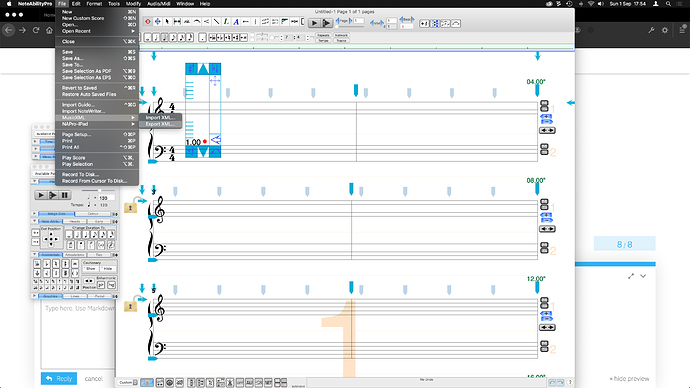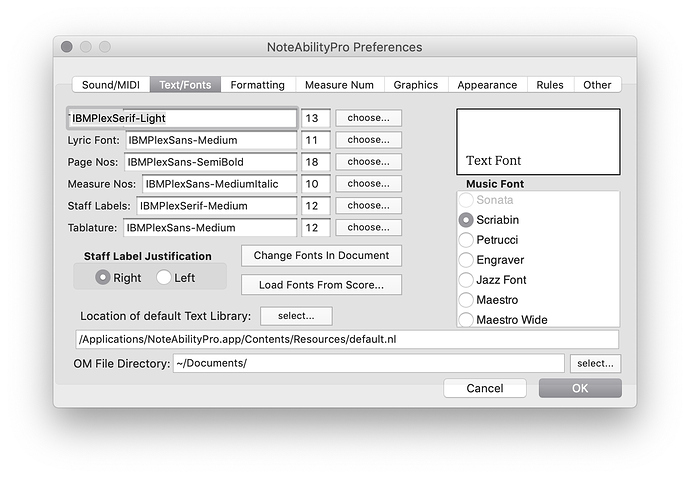Hi Antonio,
I believe you that Max has a lot of interesting functionalities that I can’t even imagine. Maybe one day, when I am less focused on what I am trying to do at the moment (write several instrumental pieces on fairly short notice for ensembles that have requested them, and also my day job), I will take a closer look at max, but for the time being, it’s processor-heaviness moots my getting familiar with it. I did take a look at the walkthrough of Bach and cage, and the possibilities looked pretty paltry compared to OM in terms of planning and executing various processes in the x/y time domain (aka pitch/frequency and time/rhythm). Maybe I didn’t have a close enough look. I suspect that I could keep myself pretty busy for a couple of years with just the standard libs plus OMTristan and OMCombine. (Bach once said something about how, if you’re ever short of ideas, you just need to read leibniz).
I’m curious what functionalities you like in Max, because aside from lots of interesting audio-based stuff, I didn’t see all that much I liked. Cage promised a comprehensive library of 20th century compositional techniques (what? no 21st century?), but as I said, it seemed kind of thin to me in that regard.
I was in contact with the person who makes NAPro and he’s not discontinuing the NAPro format. It seems like a distinction without a difference that copying and pasting is the physical thing you have to do to import om files. I haven’t had any problem with time signatures, and I didn’t try it with tempi. As far as the notes being in the right place, and the right duration and the right pitch, that’s pretty huge for me. 
I’ve been doing some quantizing today, and I came to a few conclusions: a few years ago, Jean Bresson or maybe Karim suggested that breaking things up into smaller pieces for quantization is the way to go, and while this may work sometimes, I’m finding that keeping everything in multiseq and then doing one big dump into a poly at the end is working better.
Another thing I’ve found is that it’s important to have the notes legato. I’m not sure what you would do if you really needed short durations with rests between them. I was having a lot of trouble with one particular piece today (a whole movement, as per my recommendation above), until I put it in an xmulti and ran “adjust durations/system”, which is basically the same as setting legato to 100. To get rid of very long durations, I selected all notes over 250 ms and clipped them. I also put in a lot of time signature changes, and it came out perfectly.
I am still trying to get my piece in 16ths to come out without quintuplets, but the Xmulti might help there too. (The Xmulti is really a great addition to OM, even if it’s a bit buggy and, for whatever reason, not mentioned anywhere on the forum page. In addition to its other features, it makes it really easy to do things like cross synthesis.)
Well, I look forward to hearing your personal best-of for max, maybe I will gain some enthusiasm for it. (Strangely, for all its similarity to OM, it’s just different enough that it seems like everything would have to be learned from scratch. I couldn’t even figure out how to use the bach roll, or what a bang is for (it’s like an evaluation, I guess, but different?).
Cheers,
Michal

 I am very much hoping they don’t do away with the OM exchange format, as it’s the only reliable way I’ve found to get things into NAPro (it’s true they discontinued OMNAP as a library, because it wasn’t necessary anymore, “save to NAPro” is a native feature (at least on OM 6.14, which I’m using).
I am very much hoping they don’t do away with the OM exchange format, as it’s the only reliable way I’ve found to get things into NAPro (it’s true they discontinued OMNAP as a library, because it wasn’t necessary anymore, “save to NAPro” is a native feature (at least on OM 6.14, which I’m using).
